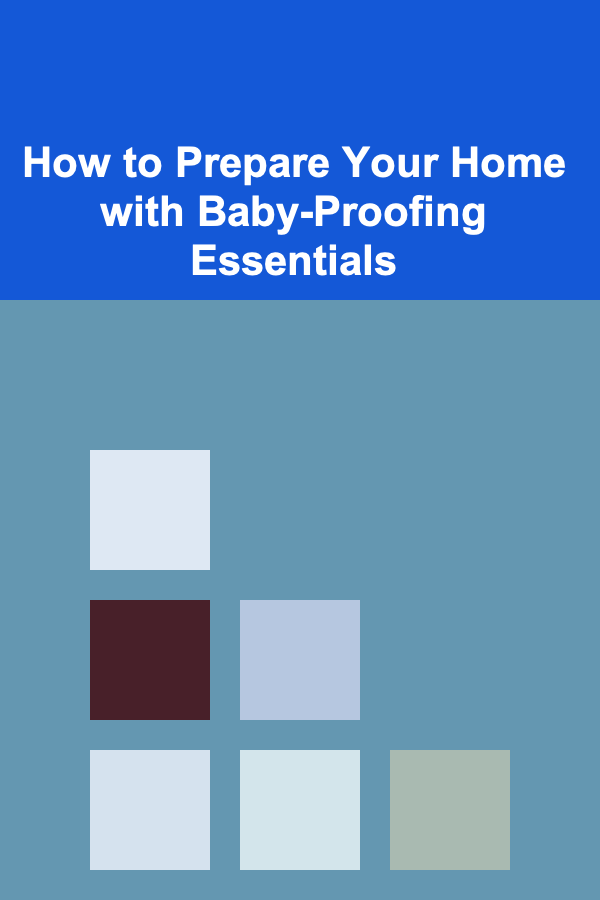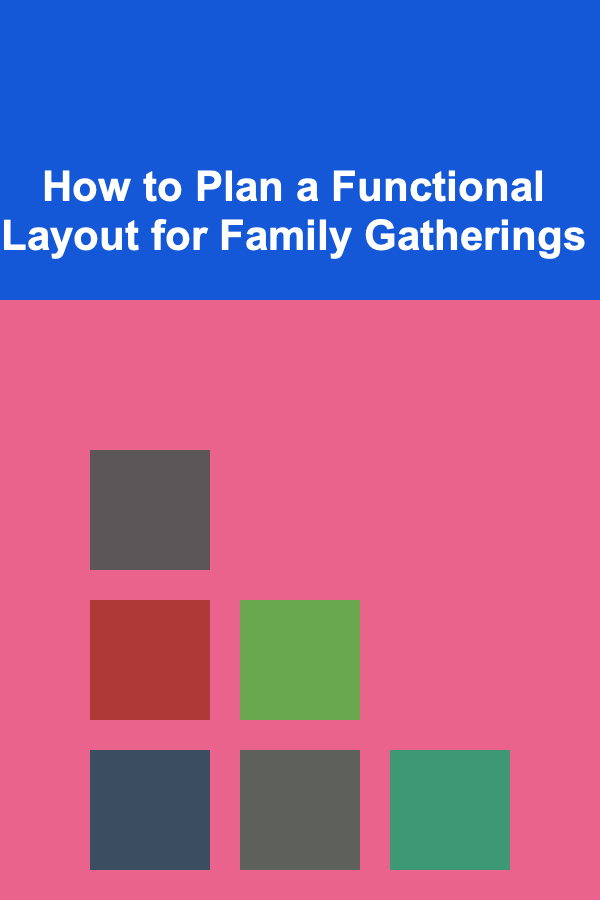
How to Prepare Your Home with Baby-Proofing Essentials
ebook include PDF & Audio bundle (Micro Guide)
$12.99$5.99
Limited Time Offer! Order within the next:

Bringing a baby into your home is a thrilling and life-changing experience. As exciting as it is to welcome your little one, it's important to ensure that your home is a safe environment. Babies are naturally curious and start exploring as soon as they're able to move, so baby-proofing is an essential task that should be done before your baby starts crawling. Baby-proofing doesn't just mean buying a few safety items---it's about making your home a secure and nurturing space for your child to grow and thrive.
This guide will walk you through the steps to prepare your home with baby-proofing essentials. From the basics to advanced measures, we'll cover the areas of your home that require attention, how to safeguard against common risks, and which products are essential in creating a baby-safe environment.
Start with the Basics: Assessing the Risks
Before diving into baby-proofing products, it's important to assess the layout of your home and identify areas that pose potential risks to your baby. This means looking at each room from the perspective of a baby's curiosity and mobility.
- Sharp Edges & Furniture: Babies are constantly learning to navigate their world, and they tend to fall as they explore. Look for furniture with sharp corners or edges that could result in injury if they tumble or bump into it.
- Electrical Outlets & Cords: Babies are fascinated by wires, and electrical outlets can be dangerous if they manage to get their fingers into them.
- Toxic Substances & Cleaning Products: Household cleaners, medicines, and other chemicals are often stored in cabinets at eye level or within reach. These substances are hazardous if ingested.
- Choking Hazards: Small objects such as coins, buttons, toys, and even small pieces of food are a choking risk. They need to be stored or removed from any area your baby has access to.
- Stairs: Whether you have a staircase inside or outside, it's crucial to keep babies from stumbling onto them, as falls from stairs can result in serious injuries.
Baby-Proofing Key Areas of Your Home
Kitchen
The kitchen is one of the most dangerous rooms in the house, filled with sharp knives, hot appliances, and toxic cleaning products. Here's how to baby-proof it:
- Cabinet Locks: Install childproof locks on lower cabinets to keep dangerous items like cleaning supplies, glassware, and sharp objects out of reach. Choose cabinet locks that can't be easily opened by little hands.
- Stove & Oven: Stove knobs should be covered with stove knob covers to prevent babies from turning them on. Additionally, use oven locks and place pot handles toward the back to prevent your baby from pulling them down.
- Countertop Protection: Keep knives, scissors, and hot items on high shelves, away from your baby's reach. A baby-friendly countertop protector can also add an extra layer of safety to prevent injuries if your child pulls something down.
- Trash Can: Consider using a childproof trash can or placing it in a cabinet with a lock, as babies love to explore the contents of garbage bins.
Living Room & Play Areas
The living room is where your baby will likely spend a lot of time, especially as they begin to crawl and explore. To keep this area safe:
- Corner Protectors: Attach soft, cushioned corner protectors to furniture with sharp edges, such as coffee tables or TV stands. This will protect your baby from any accidental bumps or falls.
- Cordless Window Blinds: Avoid the risk of strangulation by replacing traditional window blinds with cordless models. If cordless options aren't available, use cord cleats to keep blinds out of reach.
- Electrical Outlets: Install outlet covers or plug-ins in all the electrical outlets, especially in areas where your baby might spend a lot of time. This is one of the most essential items for baby-proofing.
Bedroom
The baby's bedroom needs special attention for sleep safety and overall baby-proofing:
- Crib Safety: Make sure your crib is compliant with current safety regulations. The mattress should fit snugly with no gaps, and there should be no loose bedding, pillows, or stuffed animals inside the crib.
- Baby Monitor: A baby monitor allows you to keep an eye (or ear) on your baby while they sleep, so you're immediately alerted if they wake up or get into a dangerous situation.
- Changing Table Safety: Always use a safety strap on the changing table to keep your baby secure. Never leave your baby unattended, even for a second.
Bathroom
Bathrooms can be hazardous with slippery floors, hot water, and potentially harmful products. To baby-proof the bathroom:
- Toilet Lock: A toilet lock will prevent your baby from opening the toilet lid and potentially falling in or playing in the water.
- Anti-Scald Faucet Covers: Install anti-scald devices on faucets and showerheads to regulate water temperature and prevent burns.
- Slip-Proof Mats: Place non-slip mats in the bathtub and on the floor to reduce the risk of slips and falls.
- Medicine Cabinet Locks: Lock away any medications, toiletries, and beauty products in cabinets that your baby cannot access.
Use Safety Products to Secure Your Home
There are several baby-proofing products designed to make your home safer for your little one. Here are some of the most important ones:
Baby Gates
Baby gates are essential for keeping your baby out of dangerous areas, such as stairways or rooms with too many hazards. There are several types of gates available:
- Pressure-Mounted Gates: These gates are easy to install and don't require drilling into the walls. They're great for blocking off doorways and hallways.
- Hardware-Mounted Gates: These are more secure and are ideal for blocking off stairways or areas that require extra safety.
Furniture Straps
Furniture straps help prevent heavy furniture, like bookshelves or dressers, from tipping over. These straps should be used to secure any item that could become a potential hazard if pulled or bumped by your baby.
Door Locks & Latches
Childproof door locks are essential for rooms that should remain off-limits to your baby, such as laundry rooms, bathrooms, or offices. Install latches or locks that are easy for adults to operate but difficult for babies to access.
Corner Guards
Corner guards are soft, cushioned protectors that you can apply to the sharp corners of furniture. These are especially useful for coffee tables, TV stands, and any furniture with edges that could cause injury during a fall.
Cabinet and Drawer Locks
Cabinet locks and drawer latches prevent your baby from opening cabinets that may contain dangerous items. This is especially important in kitchens and bathrooms where cleaning products, sharp objects, and medicines are commonly stored.
Baby-Proofing the Outdoors
Don't forget to baby-proof outdoor spaces like your yard, balcony, or garden. These areas can have unique risks, such as sharp tools, poisonous plants, or dangerous terrain. Here's how to baby-proof your outdoor space:
- Secure Fences & Gates: Ensure that your backyard or patio is enclosed with a secure fence that your baby can't crawl or climb over.
- Cover Pools: If you have a pool, install a baby gate around it or use a pool cover when it's not in use to prevent accidental drowning.
- Outdoor Furniture: Secure outdoor furniture or ensure that it has no sharp edges that could harm your baby. Store any gardening tools or chemicals in a locked shed or high up where your baby can't reach them.
Ongoing Safety Checks
Baby-proofing is not a one-time task. As your baby grows and develops new skills, you'll need to continue to monitor their environment and adjust safety measures as necessary. Regularly check for hazards such as:
- Items your baby can now reach as they grow taller.
- Changes in furniture or decor that could pose a new risk.
- Worn-out baby-proofing products that may no longer be effective.
Conclusion
Preparing your home with baby-proofing essentials is a crucial step to ensure your baby's safety and well-being. By taking the time to assess risks and installing the necessary safety products, you can create a secure environment that allows your baby to explore freely while reducing the chances of accidents. Baby-proofing may seem overwhelming at first, but by following a systematic approach and making small adjustments over time, you can achieve peace of mind knowing that your home is as safe as possible for your little one.

How to Adjust Portion Sizes for Individual Meal Prep
Read More
How to Collaborate with Your Wedding Planner for Success
Read More
How to Plan a Functional Layout for Family Gatherings
Read More
How To Unclog a Drain Without Chemicals
Read More
Experiencing the Safari in Kenya: A Deep Dive
Read More
How to Assemble Party Favor Boxes for Different Age Groups
Read MoreOther Products

How to Adjust Portion Sizes for Individual Meal Prep
Read More
How to Collaborate with Your Wedding Planner for Success
Read More
How to Plan a Functional Layout for Family Gatherings
Read More
How To Unclog a Drain Without Chemicals
Read More
Experiencing the Safari in Kenya: A Deep Dive
Read More